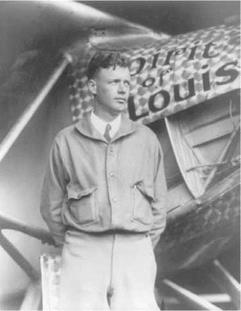1927
May 2 At Bolling Airfield, Washington, D. C., President Calvin Coolidge awards eight Army pilots the Distinguished Flying Cross for flying from San Antonio, Texas, to South America, and back. The so-called “Goodwill Flight” lasted 122 days and covered 20,000 miles. The fliers also receive the Mackay Trophy for that year.
May 4 At Scott Field, Illinois, Captain H. C. Gray pilots an untethered balloon to an unofficial world record of 42,479 feet.
May 20—21 In Paris, France, Captain
Charles A. Lindbergh, 110th Observation
|
Charles A. Lindbergh, an Army reserve officer, poses next to his record-breaking Ryan aircraft, the Spirit of St. Louis. (Library of Congress) |
Squadron, Missouri National Guard, lands his Ryan monoplane named The Spirit of St. Louis after a historic solo flight across the Atlantic Ocean from New York. His flight covered 3,648 miles in 33 hours and 39 minutes and he receives the Distinguished Flying Cross and a special Congressional Medal of Honor.
May 25 Lieutenant James H. Doolittle performs the first outside loop in his Curtiss P-18 fighter.
June 28—29 The Fokker C-2 Bird of Paradise piloted by Lieutenants Lester J. Maitland and Albert F. Hegenberger flies 2,407 miles between Oakland, California, to Oahu, Hawaii, in 25 hours and 50 minutes. They receive the Distinguished Flying Cross and the Mackay Trophy for their efforts.
October 12 In Dayton, Ohio, McCook Field closes and is replaced by Wright Field, where aeronautical testing and development continues apace.
NOVEMBER 4 An Army hydrogen balloon flown by Captain Hawthorne C. Gray breaks all altitude records by reaching 42,470 feet, but he dies from lack of oxygen. His demise highlights the need for pressure suits and oxygen systems.
December 10 In Washington, D. C., Colonel Charles A. Lindbergh is voted a Congressional Medal of Honor for his epic transatlantic crossing.
December 14 Major General James to a command position, gains appoint-
Fechet, who rose from the enlisted ranks ment as chief of the Army Air Corps.











